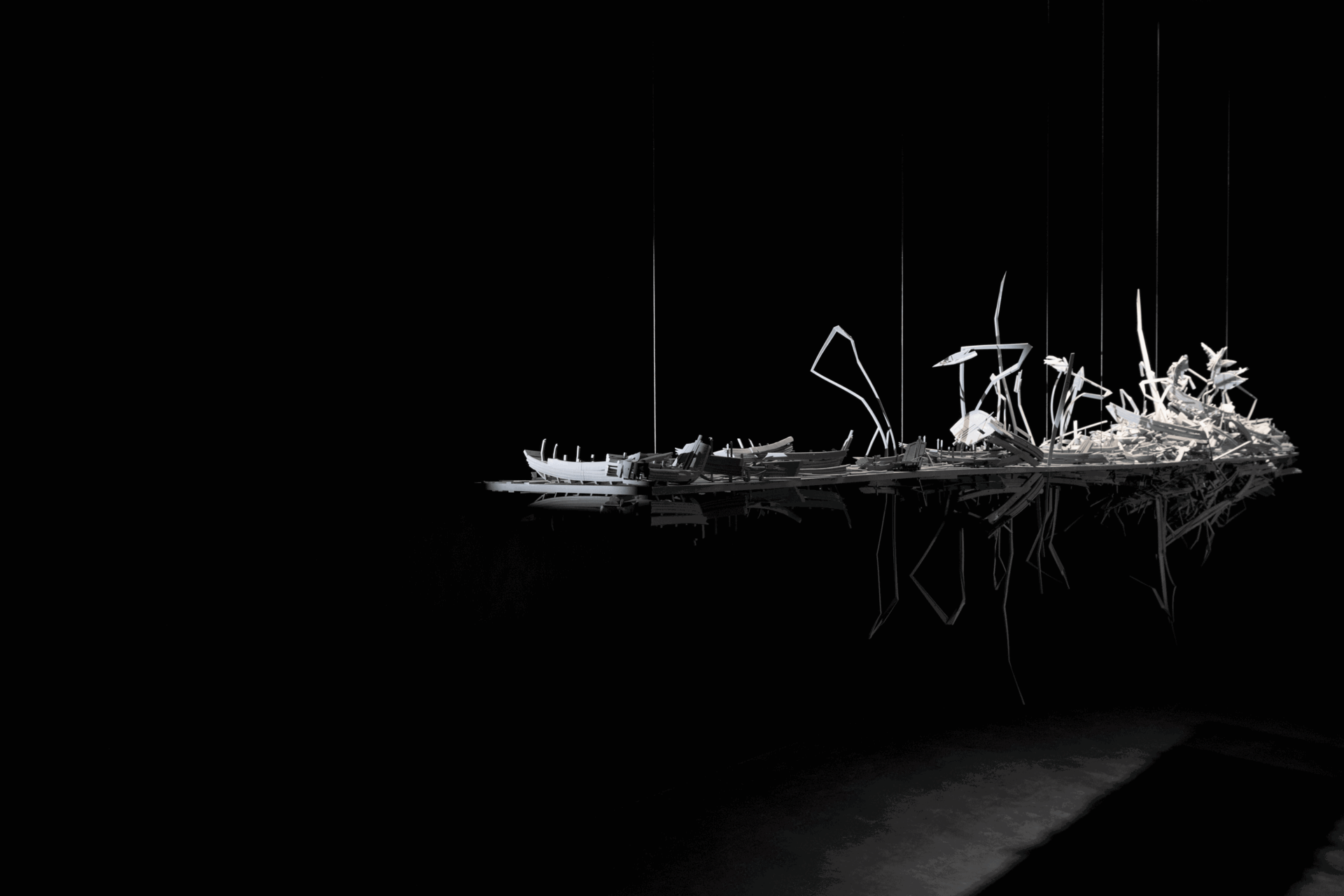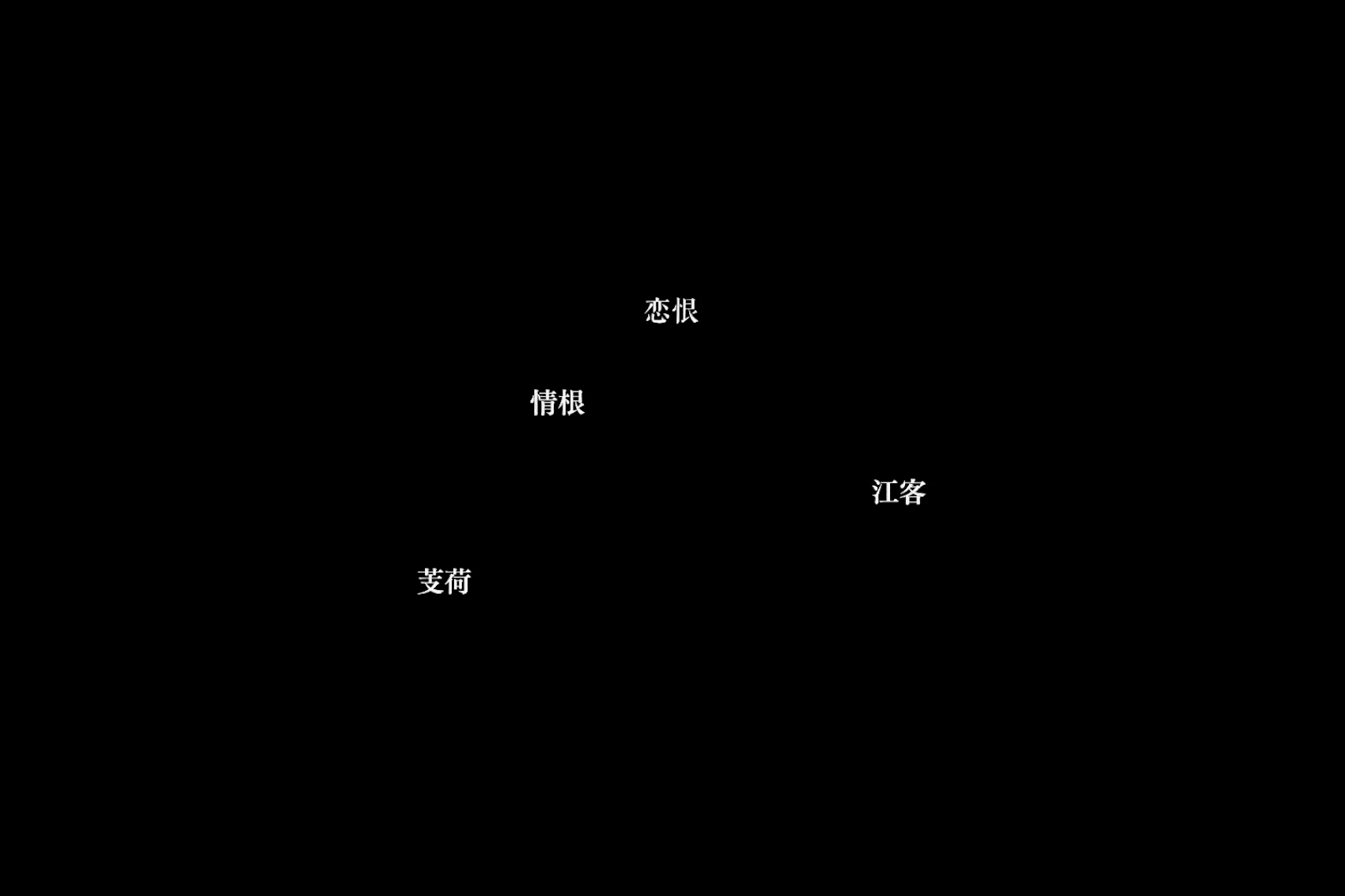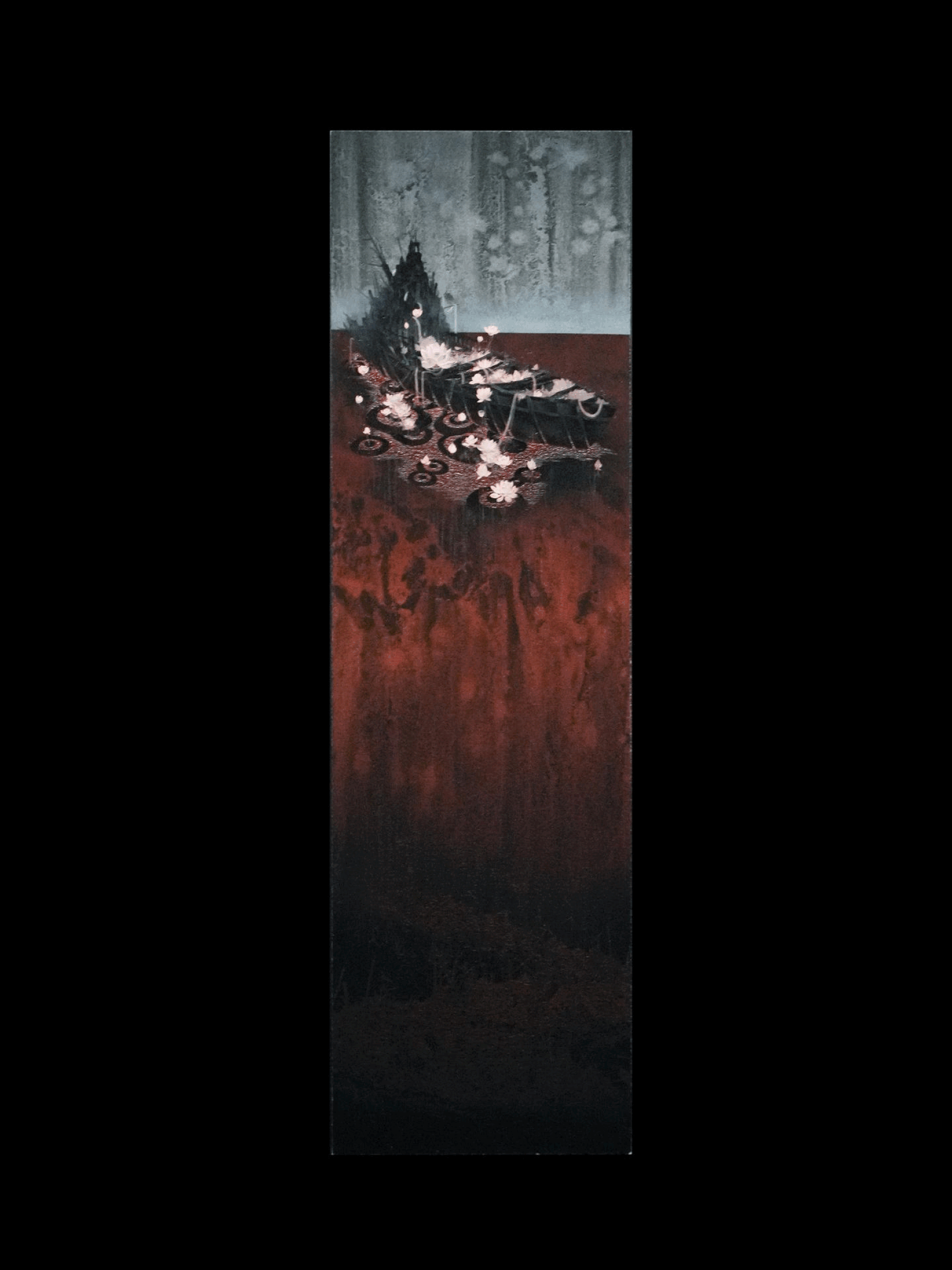查看完整案例

收藏

下载
2024 年,由松江区文化和旅游局、同济大学建筑与城市规划学院联合主办的“造化——新江南空间艺术”展览在松江云间会堂文化艺术中心开幕,展览从装置、图像、影像和文字四个维度深入挖掘和提炼江南营造文化。
▼荣枯之舟,The Boat of Birth and Death ©Pills Architects
PILLS 主持建筑师王子耕作为受邀艺术家参展,本次展览由王子耕的装置、黄晓丹的文字以及赵清的绘画创作共同完成。作品“荣枯之舟”以江南地区常见的木舟为原型,置于舟状的木制展厅中,引导观众沿着黑色坡道缓缓走入“船舱”内部观展。
Zigeng Wang, the founder and principal architect of PILLS, was invited to participate in the exhibition. The show features a collaborative work, with Zigeng Wang’s installation, Xiaodan Huang’s text, and Qing Zhao’s painting. The artwork “The Boat of Birth and Death” is modeled after a wooden boat in the south of the Yangtze River in the Jiangnan region. It is placed within a boat-shaped wooden exhibition hall, guiding visitors to slowly walk along a black ramp into the “boat cabin” to experience the exhibition.
▼展览设计轴测,Exhibition design axon ©Pills Architects
▼展览外部空间,External space of the exhibition ©陈颢
▼展览外部光源,External light sources of the exhibition ©Pills Architects
▼展厅外部支撑结构,External supporting structure of the exhibition ©Pills Architects
在动念与跌入之间,在盛放与残败的往复交替中,宿命般地一再选择,一再错过,一再步向同一种结果。
Between the rise and fall of thoughts, in the cycle of bloom and decay, one endlessly repeats the same fallout: choosing, then missing.
—— 王子耕,Zigeng Wang
▼“荣枯之舟”主体装置,“The Boat of Birth and Death”Installation ©Pills Architects
王子耕的参展作品构想了一个在水面水下、不同时间密度交织的世界中,一条船反复驶向目的地,却又反复沉入江底的场景。作品主体由无数残破的木舟碎片堆积而成,经过拼接与重组形成了多维度的空间结构。通过控制正交两个方向的投影灯光,装置投影产生出两种样貌:一方是破败的残荷剪影,一方是绽放的莲花。废墟的正、侧投射影像交替呈现,在动念与跌入之间,在盛放与残败的往复交替中,宿命般地一再选择,一再错过,一再步向同一种结果。
Zigeng Wang’s exhibited work envisions a scene in a world where water, the underwater, and varying densities of time intertwine. At its core, a boat endlessly sails towards its destination, only to sink repeatedly to the riverbed—a haunting metaphor for destiny. The centerpiece of the artwork is a multidimensional structure composed of countless fragments from broken wooden boats. These fragments are stitched and reassembled, forming a spatial narrative of destruction and renewal. Through precise projection lighting in two orthogonal directions, the installation reveals dual realities: one side casts the silhouette of withered lotus leaves, while the other blooms with vibrant lotus flowers. This interplay of light and shadow alternates between ruin and regeneration, as frontal and side projections shift in visual rhythm. Between the rise and fall of thoughts, and the endless cycle of bloom and decay, the work reflects the human condition: the perpetual fallout of choices made and chances missed.
▼“荣枯之舟”装置顶视效果图,Top View Rendering ©Pills Architects
▼装置投影前后,Before and After the Projection ©陈颢
▼装置正投影-破败的残荷,Frontal Projection of the Installation – withered lotus silhouette ©Pills Architects
▼装置侧投影-绽放的荷花,Side Projection of the Installation – blooming lotus flowers ©Pills Architects
我们从李商隐的绝句《暮春独游曲江》中提取了“恨”“情”“江”“荷”四字,将它们的衍生词组以递进关系置于情绪的谱系中,呈现情将人置于甜蜜与痛苦的两极之间徘徊拉扯的状况,这是对李商隐诗句的再度朦胧化。
We extract the four characters, “hate,” “love,” “river,” and “lotus” from Li Shangyin’s stanza “Traveling Alone to Qujiang River in Late Spring,” and combine them into derivatives that each claims a position in the spectrum of emotions. It presents the situation in which love thrusts a person between the opposites of sweetness and pain. This is a re-mystification of Li Shangyin’s poem.
—— 黄晓丹,Xiaodan Huang
▼黄晓丹创作的文字投影部分内容
Some of the content of the textual projections created by Xiaodan Huang ©Pills Architects
投影的文字部分由黄晓丹创作,来源于对李商隐诗歌的变形。我们从李商隐的绝句《暮春独游曲江》中提取了“恨”“情”“江”“荷”四字,将它们的衍生词组以递进关系置于情绪的谱系中,呈现情将人置于甜蜜与痛苦的两极之间徘徊拉扯的状况,这是对李商隐诗句的再度朦胧化。在视觉上,词组的闪烁制造语言的蒙太奇效果,模拟人在不变的轮回中,体验却经历着变化摇摆。
The text created by Xiaodan Huang, comes partly from the reiteration of Li Shangyin’s poetry. We extract the four characters, “hate,” “love,” “river,” and “lotus” from Li Shangyin’s stanza “Traveling Alone to Qujiang River in Late Spring,” and combine them into derivatives that each claims a position in the spectrum of emotions. It presents the situation in which love thrusts a person between the opposites of sweetness and pain. This is a re-mystification of Li Shangyin’s poem. Visually, the flickering of the phrases creates a verbal montage, simulating a human being’s experience of changes and oscillations amid the eternal cycle.
▼黄晓丹于展览现场,Xiaodan Huang at the exhibition site ©Pills Architects
▼黄晓丹于展览现场,Xiaodan Huang at the exhibition site ©Pills Architects
水面与水下看似不同的世界其实牵连彼此,破败与生机相互成就,生命与死亡也并无不同,只是一种沿于时间走向的转变。
The two seemingly separate worlds about the water are thus linked where decay and bloom complement each other. Life and death are not dissimilar, but only a continuity that morphs over the trajectory of time.
—— 赵清,Qing Zhao
展厅左侧悬挂着赵清的绘画作品。画作采用两种丙烯颜料绘制,通过光线控制,画作展现出两层叙事脉络。在普通灯光下,残破的船与莲花漂浮在水面上;在紫光灯照射下,荧光颜料由隐渐显,画面展现出隐藏的叙事线索,从船体构成的废墟世界中生出一支支莲茎直通池面浮荷。水面与水下看似不同的世界其实牵连彼此,破败与生机相互成就,生命与死亡也并无不同,只是一种沿于时间走向的转变。
On the left side of the exhibition hall hangs Qing Zhao’s painting, a work that intertwines two layers of narrative through the careful overlap of pigments and the precise manipulation of light. Under normal lighting, the painting reveals a damaged boat amidst blooming lotus flowers on the water’s surface. However, when illuminated by ultraviolet light, a hidden narrative emerges: the wrecked ship is uncovered, with stems reaching out from its ruins to support the lotus life floating atop the water. The two seemingly separate worlds are thus intertwined, showing that life and death are not opposites, but only a continuous transformation along the trajectory of time.
▼赵清画作在不同光线下的呈现
Qing Zhao’s painting under different lighting ©Pills Architects
为了营造多感官的江南意蕴,展厅内墙贴上了涂墨宣纸,隐隐散发墨香,气味与投影将观众拉入一个模糊了时间与情绪的虚空场域。黑色的墙体消解了展厅的边界,突破了视觉的固有框架,在投影灯光下,画作、文字与装置成为空间中视觉的主要引导。破碎重叠的木舟与转变的光影,将不同的时空并置在眼前的装置上;来自不同方向的光线投影产生相斥的影像,将矛盾的故事与莲花的枯荣隐入黑白间的混沌中。在混沌之间,人的感慨在船、文字与影像之间重复反射,情绪也在反射中变得更加丰富与强烈,凝结成文学中的“涵咏”,观众自我感知、自我对话的场域得以在此展开。
To evoke the multisensory essence of Jiangnan, the exhibition hall’s walls are adorned with ink-painted Xuan paper, gently releasing the fragrance of ink into the air. This scent, paired with immersive projections, blurs the lines between time and emotion, drawing the audience into a contemplative void. The black walls dissolve the hall’s physical boundaries, erasing conventional visual frameworks and creating an ethereal spatial experience. Under the projected lighting, the painting, text, and installation become the main visual guides within the space. The fragmented, overlapping boat with the shifting light and shadow juxtaposes different times and spaces in front of the viewer. Under the shifting play of projected light, the fragmented, overlapping boat becomes a dynamic focal point, juxtaposing different times and spaces before the viewer. Lights cast from multiple directions form opposing images, weaving together conflicting narratives. Within this interplay of light and shadow, the ebb and flow of lotus flowers emerge, suspended in an enigmatic abyss of black and white. In this space, human emotions reverberate between the fragmented boat, flowing text, and layered images, becoming more profound and resonant—much like the introspective process of “deep meditation” in literature. The exhibition transcends its physical boundaries, inviting the audience into a realm of heightened self-awareness and internal dialogue.
▼展览现场照片,Exhibition photos ©陈颢
▼展览现场照片,Exhibition photos ©陈颢
凝望作品,装置、文字与画作三者从三个维度对江南意蕴进行了阐释与转译,旋流汇聚此处。观众所有的视线投影在作品上,又越过作品本身,最后到达其身后的虚空,接触到世界的虚景,真实的边界在此处混淆。在含混之中,不分黑白、没有昼夜、爱恨挪移、千斤化羽,只有一次次重复跌入的虚象。虚像不息的运转,周而复始,成住坏空。
Beholding the artwork, the installation, text, and paintings converge to reinterpret the essence of Jiangnan across three dimensions, swirling together within the space. The viewer’s gaze lingers on the piece before extending beyond it, into the void—where the illusory nature of existence emerges, and the boundaries of reality dissolve into ambiguity. Amid the abyss, there is no black and white, no day and night. Love and hate flips, and the weight of a thousand pounds dissipates into that of feathers. What remains is an illusion—unceasingly flickering, collapsing, and reforming—plunging endlessly into the Samsāra of becoming, sustaining, destruction, and emptiness.
▼荣枯之舟,The Boat of Birth and Death ©陈颢
▼装置细部照片,Installation detail photos ©Pills Architects
▼装置细部照片,Installation detail photos ©陈颢
▼装置细部照片,Installation detail photos ©陈颢
项目信息
项目类型:展览空间及艺术品设计
项目位置:上海松江云间会堂文化艺术中心
装置及空间设计艺术家:王子耕
文字创作艺术家:黄晓丹
绘画创作艺术家:赵清
装置设计与制作:PILLS刘师麟、徐译、汪曼颖、张鑫、刘培彦、王楷竣、尤佳欣
灯光顾问:马秀虹
灯光赞助:深圳市埃克苏照明系统有限公司
宣纸制作:北京如一堂文化传媒服务有限公司
艺术物流:寿星托桃(北京)艺术品展览服务有限公司
展览信息
展览名称:“造化——新江南空间艺术”展览
联合主办:上海市松江区文化和旅游局、同济大学建筑与城市规划学院
总策展人:谭峥
联合策展人:俞泉
展览时间:2024 年 7 月 19 日-2024 年 9 月 15 日



























